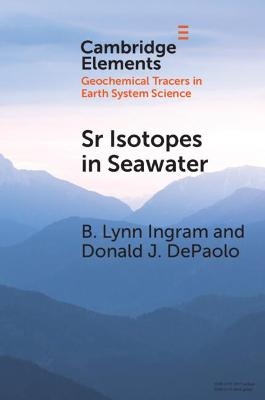
Sr Isotopes in Seawater
Stratigraphy, Paleo-Tectonics, Paleoclimate, and Paleoceanography
Seiten
2022
Cambridge University Press (Verlag)
978-1-108-99429-3 (ISBN)
Cambridge University Press (Verlag)
978-1-108-99429-3 (ISBN)
Studies of Sr isotopic composition of thousands of samples of marine sediments and fossils have yielded a curve of 87Sr/86Sr versus age for seawater Sr that extends back to 1 billion years. Because the ratio is always uniform in the oceans globally at any one time, it is useful as a stratigraphic correlation and age-dating tool.
Studies of Sr isotopic composition of thousands of samples of marine sediments and fossils have yielded a curve of 87Sr/86Sr versus age for seawater Sr that extends back to 1 billion years. The ratio has fluctuated with large amplitude during this time period, and because the ratio is always uniform in the oceans globally at any one time, it is useful as a stratigraphic correlation and age-dating tool. The ratio also appears to reflect major tectonic and climatic events in Earth history and hence provides clues as to the causes, timing, and consequences of those events. The seawater 87Sr/86Sr ratio is generally high during periods marked by continent-continent collisions, and lower when continental topography is subdued, and seafloor generation rates are high. There is evidence that major shifts in the seawater ratio can be ascribed to specific orogenic events and correlate with large shifts in global climate.
Studies of Sr isotopic composition of thousands of samples of marine sediments and fossils have yielded a curve of 87Sr/86Sr versus age for seawater Sr that extends back to 1 billion years. The ratio has fluctuated with large amplitude during this time period, and because the ratio is always uniform in the oceans globally at any one time, it is useful as a stratigraphic correlation and age-dating tool. The ratio also appears to reflect major tectonic and climatic events in Earth history and hence provides clues as to the causes, timing, and consequences of those events. The seawater 87Sr/86Sr ratio is generally high during periods marked by continent-continent collisions, and lower when continental topography is subdued, and seafloor generation rates are high. There is evidence that major shifts in the seawater ratio can be ascribed to specific orogenic events and correlate with large shifts in global climate.
Introduction; Sources and sinks of Sr in the oceans; How uniform is the 87Sr/86Sr of modern seawater?; Measuring 87Sr/86Sr ratios; Dating and Correlating Marine Sediments Using Sr Isotopes; The geologic meaning of seawater 87Sr/86Sr fluctuations; Concluding comments; Key papers.
| Erscheinungsdatum | 21.03.2022 |
|---|---|
| Reihe/Serie | Elements in Geochemical Tracers in Earth System Science |
| Zusatzinfo | Worked examples or Exercises |
| Verlagsort | Cambridge |
| Sprache | englisch |
| Maße | 153 x 228 mm |
| Gewicht | 69 g |
| Themenwelt | Naturwissenschaften ► Geowissenschaften ► Geologie |
| Naturwissenschaften ► Geowissenschaften ► Meteorologie / Klimatologie | |
| ISBN-10 | 1-108-99429-6 / 1108994296 |
| ISBN-13 | 978-1-108-99429-3 / 9781108994293 |
| Zustand | Neuware |
| Haben Sie eine Frage zum Produkt? |
Mehr entdecken
aus dem Bereich
aus dem Bereich


